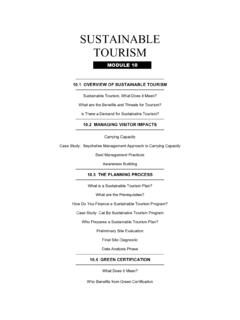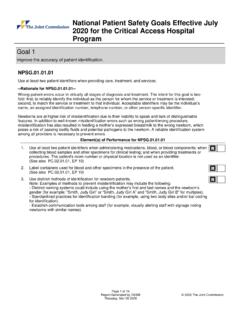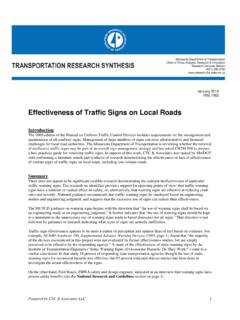Transcription of Effective techniques for the promotion of library services ...
1 VOL. 21 NO. 1, MARCH, 2016. Contents | Author index | Subject index | Search | Home Effective techniques for the promotion of library services and resources Zhixian Yi Abstract Introduction. This study examines how Australian academic librarians perceive techniques for promoting services and resources, and the factors affecting the perceptions regarding effectiveness of techniques used. Method. Data were collected from an online survey that was sent to 400 academic librarians in thirty-seven Australian universities. The response rate was Analysis. The qualitative data were analysed using content analysis. The collected quantitative and qualitative data were analysed using descriptive and inferential statistics (ordinal regressions).
2 Results. Librarians used a variety of techniques to promote services and resources. Demographic variables, human capital variables and library variables were significant predictors of perceptions of the Effective promotion techniques used. However, this study indicates that other independent variables such as number of different library professional positions and years involved in all library services made no difference. Conclusions. This study provides a better understanding of academic librarians' attitudes and views towards techniques for promoting services and resources. Librarians may use the results to reflect on the effectiveness of these techniques , to balance the weight of the factors' influences and to better understand various promotion techniques .
3 This will enable them to promote library services and resources more effectively in the future. change font Introduction In this digital age, academic libraries are facing a variety of challenges such as ongoing budget cuts, application of new information technologies, changing internal and external environments, and changing demands of research and teaching. A managerial tool assisting libraries to face challenges now and in the future is Effective promotion and marketing. Today, academic libraries are no longer the only choice for students, faculty, staff and other clients to go to for information. To attract clients, generate non-user awareness, and raise awareness of available services and resources, libraries need to find ways to promote services and resources to clients as effectively as possible.
4 As such, promotional approaches are used to convey the availability and value of services and resources to target markets and should be designed to cause library users and non-users to act (Helinsky, 2008; Webreck Alman, 2007). These approaches must be developed in such a way that they gain user attention, providing a reason for the library 's services and resources to be selected over those of competing services (Chartered Institute of Marketing, 2009). Promotional approaches Promotional tools that can be used by academic libraries to promote their services and resources include: digital media, such as the library 's Website, e-mail lists, blogs and podcasts; print materials, such as posters, handouts and giveaways.
5 Events such as orientation tours and workshops; and other tools such as library publications, contests, brochures, direct mail, Web applications and displays (Fisher and Pride, 2006; Mathews, 2009; Webreck Alman, 2007). A good Website helps to bring services and resources together in a unique way, because it is a direct link between the library and its specific users (for example students and academics) and the services it is seeking to promote. It also provides a channel for communication with target clients. Some media can be cross functional; for example, traditional tools, such as flyers, brochures and posters, can be used to promote events and programmes, which are promotional tools in themselves.
6 Newsletters can introduce new developments as well as highlight current services . Target audiences can be easily and effectively targeted through e-mail lists and the Internet. These services are cost Effective , as they require little investment in resources and reach the intended client directly. This study examined how Australian academic librarians perceive techniques used to promote their services and resources and the factors influencing their perceptions of the particular approaches used, to provide a better understanding of their attitudes and views towards these techniques . Librarians may use the results to reflect on the effectiveness of these techniques , to balance the weight of the factors' influences and the better to understand various promotion techniques .
7 This will enable them to promote academic library services and resources more effectively in the future. Literature review Information technologies change rapidly. Information products and services are in a multiplicity of formats in libraries. For libraries and information services to stay viable in the current climate, it is important that they adopt marketing strategies to help meet organizational mission,goals and objectives. Marketing has long been associated with the selling of a product in order to make a profit, but was extended to the non-profit sector including libraries in the 1960s (Enache, 2008, p. 477). For libraries, marketing is about a set of activities including understanding client needs, determining market niches, identifying products and services , building client relationships and creating 'marketing mix' (de Saez, 2002; Potter, 2012.)
8 Rowley, 2003; Welch, 2006). Unlike traditional marketing that is organization- focused and for a specific product, libraries and information agencies are client- focused organizations focusing on clients and meeting their needs, and need to adopt services marketing (Welch, 2006, p. 14).. services are the intangible products that libraries now have to promote in order to compete with external competitors. Libraries face numerous challenges such as restricted funding and increasing user expectations, as they identify, develop, deliver and monitor service offerings that are superior to their competitors. However, these challenges offer opportunities to provide better services for users by redefining customer relationships through the use of marketing strategies to build and strengthen ongoing relationships with customers (Rowley, 2003, p.
9 14). Relationship marketing is relevant to services marketing and creates much value because it builds a viable and long-term relationship with the clients that seek to use resources and services so that the customers are retained (Rowley, 2003). The marketing mix refers to a set of variables that can be used by a library to promote its services and resources to users (de Saez, 2002; Lancaster and Reynolds, 1995; Welch, 2006). The marketing mix is traditionally referred to as the 4 Ps: price, product, promotion and place; however the fifth P, people, is now commonly included. Although the marketing mix was developed for imparting the advantages of a tangible product, with the focus on product marketing, the literature agrees on the importance of applying this focus to service promotion .
10 As the need for promotion of services has grown and is now more widely recognised, the marketing mix has been refined and adapted to include services , not just products (Mollel, 2013). One of the key marketing mix strategies is Effective promotion . A comprehensive literature search has shown increasing interest in the necessity of appropriately promoting library services and resources, as well as the critical need to do this to maintain literature agrees that marketing and promotion are often used interchangeably; however, they are quite different, with promotion being a subset of marketing, as outlined above in the marketing mix (Mollel, 2013; Germano 2010; Seddon, 1990).















